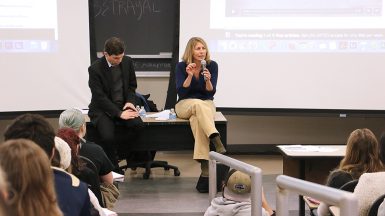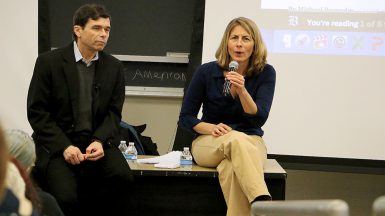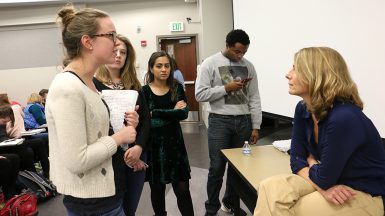Spotlight reporters recount steps in Pulitzer Prize-winning series

“Comfort the afflicted, and afflict the comfortable.”
This mantra has long been seen as an essential function of journalism. But how do you comfort victims of sexual abuse who have been silenced for years by an institution as comfortable as the Catholic Church and is seen as the epitome of morality? How do you do this in the “country’s most Catholic city”?
Sacha Pfeiffer and Mike Rezendes of the Boston Globe’s Spotlight team visited professor of practice Tom French’s Behind the Prize Class Monday to tell students exactly how they exposed the decade-long cover-up of clergy committing child molestation in the Boston Archdiocese.
The series of stories about the scandal were so significant that the team was awarded the Pulitzer Prize for public service in 2003 and inspired the Oscar-nominated film Spotlight, with Mark Ruffalo as Rezendes and Rachel McAdams as Pfeiffer.
But a Pulitzer gold medal and a blockbuster were never the motivation for the hard work the team did, according to Rezendes. Uncovering the truth was reward itself.
“If you want to make a lot of money, I wouldn’t go into journalism,” said Rezendes. “But a life of investigative reporting is a life of meaning and purpose.”
The pair stressed throughout their talk that to do work that is as rewarding as Spotlight’s project, sacrifices must be made and roadblocks removed.
For example, the Catholic Church in Boston had placed a seal on legal documents concerning sexual abuse cases involving priests, and the Globe took legal action to gain access to the files. Rezendes said the award-winning stories would never have been published without the legal expertise and financial power provided by the Globe.

“It takes power to go up against power,” he said. “This is why we need big media.’
For sources that couldn’t be coerced legally, each reporter had their own strategy for extracting information.
Pfeiffer told students it is important to find the balance between pushing sources to give information and protecting sources from saying too much.
“I would get in the habit of reading quotes back to my sources and asking ‘Now, are you sure you want that off the record? It seems pretty benign to me,’” she said. “The majority of the time they would change their mind.”
In another instance, however, Pfeiffer told a source that she could not use their interview after he revealed that his wife would find out he was victim of sexual abuse when she read the newspaper.
Rezendes likened his method for getting information from sources to courting a potential date.
“I always say I like to romance or marry my sources,” he said. “You have to make them trust you and like you and like talking with you before they will give you the information you need.”
The team also highlighted the importance of not only getting sources to talk, but finding the sources with the right information. Oftentimes, the subject of an investigative story is complex and requires journalists to submerse themselves into the world of that subject. Finding a source that is at the center of that world can be key to the investigation, according to Pfeiffer.
For the Spotlight team’s investigation of the Catholic Church, this source was Richard Sipe. The pair compared Sipe to an “academic” whose research followed the trend of priests who prey on children sexually. A former priest himself, Sipe gave the team insight into the unimaginable scale of the sexual abuse problem that plagued the Catholic church all around the world, not just in Boston.

“One of the greatest things about being a journalist is having access to incredible information and experts that you wouldn’t have otherwise,” said Pfeiffer. “There’s always someone out there whose expertise is what you’re reporting on.”
In addition to discussing their Pulitzer Prize-winning piece, the pair shared tips from other journalistic projects they had worked on. Pfeiffer played the class clips of an on-air interview from her time at Radio Boston in which her guest challenged the facts she was presenting.
“I remember at the Globe the development reporter who sat near me would scream at sources on the phone,” she said. “You can’t do that when you’re doing a live interview. You have to remain calm and decide how to respond in a split second.”
Rezendes shared a recent project investigating prison guards assaulting and even sometimes murdering mentally ill inmates with no consequence. He showed the class a prison surveillance video of guards using deadly force to restrain an inmate having a schizophrenic episode.

The video is grainy, and the large number of guards in the small cell makes it hard for viewers to decipher what actually is happening. Rezendes said that sometimes reporters think having a video recording of an event will make an investigation easy, when in fact it can complicate it.
Regardless of whether the report was broadcasted or written or exposing abuse in the Catholic Church or in prisons, many students wanted to know how good journalists find stories worth reporting. Rezendes and Pfeiffer told students that the best stories can be found where no one is looking. Rezendes advised the best way to correct policies and practices is to challenge systems and avoid making assumptions.
“Never be cynical, but always be skeptical,” he said.
More:

